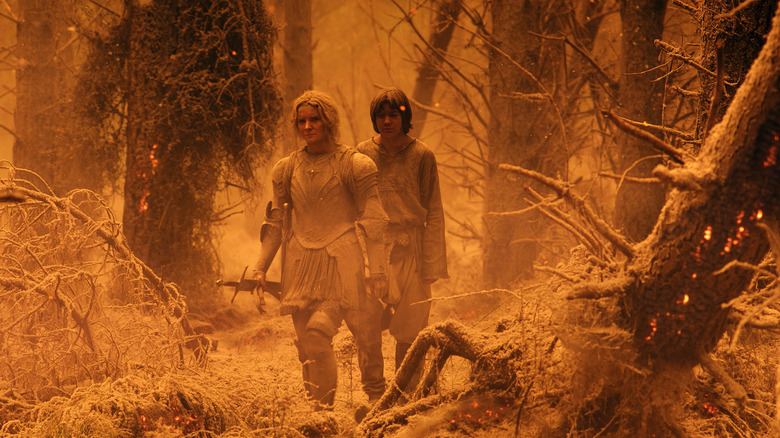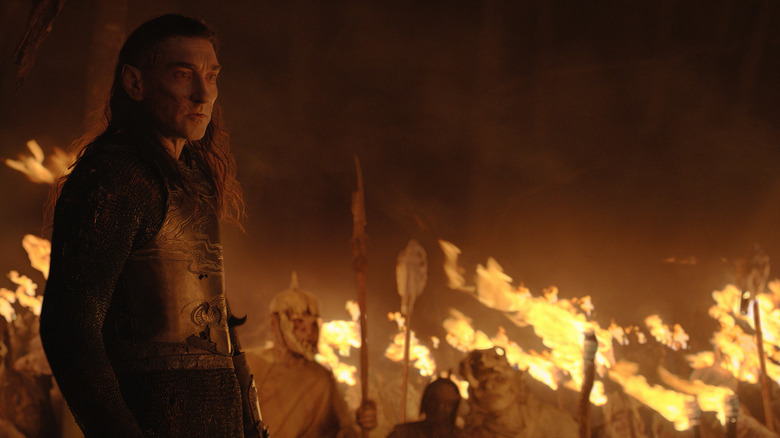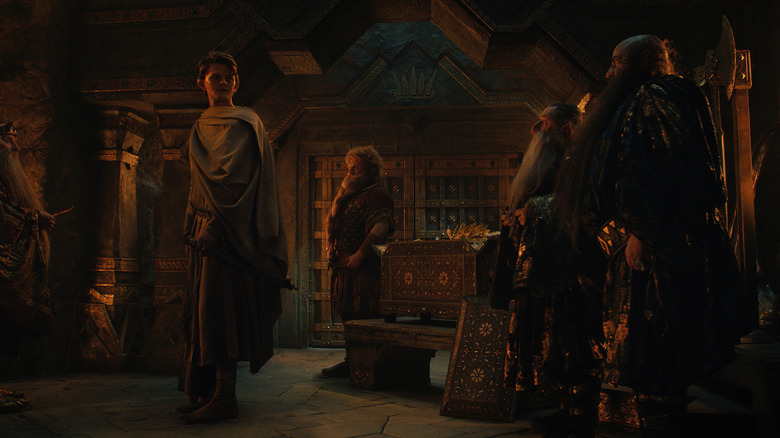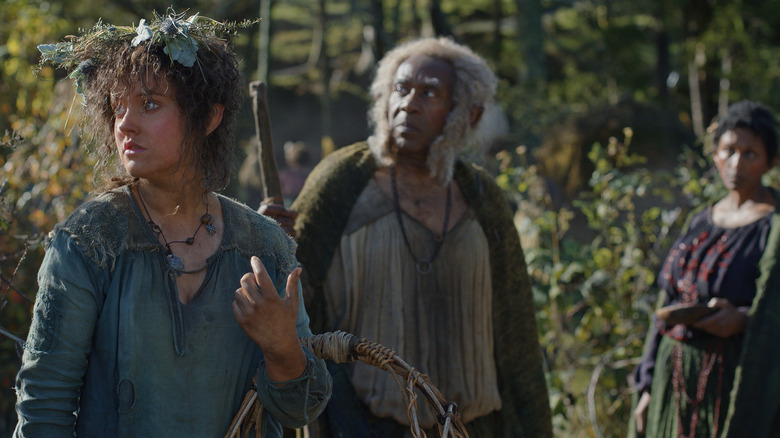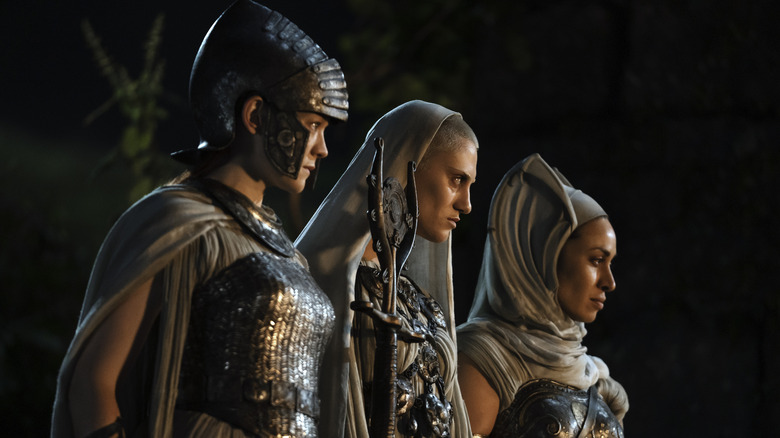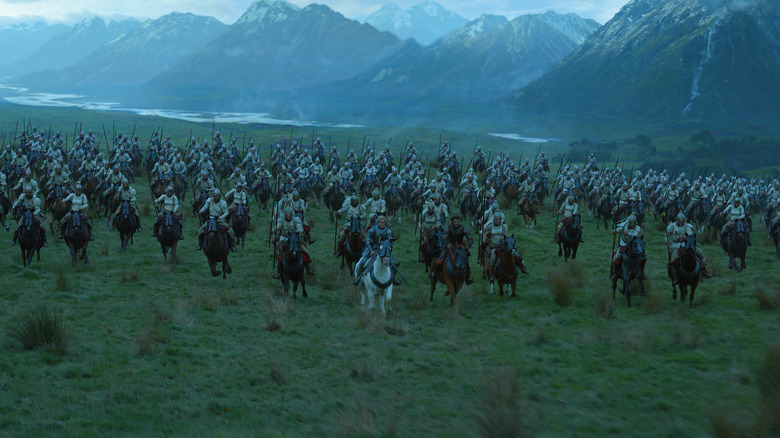The Rings Of Power Cinematographer On 'Creating Hell On Earth' And Making Night Scenes Watchable [Exclusive Interview]
Things are heating up in "The Rings of Power" in the season's last two episodes — there have been explosions, battles, and more than a couple scenes of characters traipsing around in the night. Shooting these various sequences across Middle-earth creates a lot of challenges for the show's director of photography or cinematographer, who's responsible for all the lighting and camera angles (and many other things) for the production.
I talked with Alex Disenhof, the director of photography for the sixth and seventh episodes of "The Rings of Power" about how he approached crafting the mood and atmosphere for several key scenes. Read on for that discussion, though be warned!
This interview contains spoilers for "The Rings of Power" through this season's seventh episode, "The Eye."
This interview has been condensed and lightly edited for clarity.
'We decided that it should look like hell on Earth, like the middle of a wildfire'
To kick us off, I wanted to start talking about the beginning of 107 when we open on what is soon to be officially called Mordor. The red, the haziness — it was really impactful. How did you approach creating the look and feel of that sequence?
We first needed to collect references and understand as a collective unit what effects we were after. So I ended up finding a bunch of wildfire references from the California wildfires in 2018, and also my own experience in Portland, Oregon, where I was very close to a wildfire and had my own photography from it. What struck me in those instances was the color of the sky and the color of the atmosphere — this and researching volcanic events and what or could happen in such an event, we decided that it should look like hell on Earth, like the middle of a wildfire.
That was our jumping off point, and from there it was all about how do we accomplish that. We knew we needed to have control of the atmosphere and control of the color of the light as much as possible for the bulk of our scenes. So we rebuilt the now-ruined village on stage, and we tested for weeks with different color lights and figured out what combination look good.
What you see in the finished product is a huge amount of it is practical — the color itself is straight out of camera. There's very little color correction because frankly, it was so specific of a color you couldn't really push it one way or the other later. And the visual effects team added the chaotic ashes flowing through and sparks, because for health and safety reasons on the day, we couldn't do that.
But a lot of what you see is actually in camera. We also surrounded the set with muslin instead of green screen, and with the atmosphere that we had, the very heavy atmosphere, it had a natural fall-off into this hazy depth, which the visual effects team could then augment using shapes of burned out buildings in the far background. There was no blue or green screen for any of those sequences.
'The shadows would be red, the mid-tones would be orange, and the highlights would naturally go to yellow'
Oh, wow.
Yeah, and then finally, we had these scenes out in the woods in the forest as our characters slowly make their way away from the epicenter. That was a challenge because first because I had to match what we created on stage, where I had all this control over the light and the atmosphere. To compensate for the fact that we didn't have as much control, we used filters in the camera, and we did some color correction in the camera on the shoot day, and we worked with our special effects department and the visual effects department to combine all that together to match those sequences.
And then essentially as they get further and further away, I use different filters in the cameras to peel back the look a little bit to make it less intense and less intense, until finally our characters are out of it.
You mentioned when you were on set for those very first scenes you set up a system, so the red was very consistent. Can you talk a little bit more about that?
We used LED lights and surrounded the set with hundreds of lights in the ceiling through diffusion material and created this really soft red glow. And we picked a color red that worked well with the cameras that we were using so that it created this gradient naturally, where the shadows would be red, the mid-tones would be orange, and the highlights would naturally go to yellow. We had this nice color gradient, even though it was a very narrow spectrum of color.
'We shot in hard sunlight or created sunlight when the sun wasn't there with the New Zealand weather'
One of the other things I noticed when looking at the different scenes is that different places that in Middle-earth have different color schemes and brightness to them. The harfoots, for example, and then also the Dwarves in the mountain. How did you approach creating the atmosphere for both of those places?
In our show, we are lucky to have different worlds to live in within the larger world, which gives us a broad range of visuals to work with. So for the harfeet, for instance, it was all story led — they are very much in nature, they live off the land, they're travelers, and we wanted to always make sure they felt incorporated into that.
When they get to this grove area in episode 107, it was important to show that it was burned out, so we tried to avoid direct sunlight for that. We tried to block it out the sun as much as we could, to make it feel more depressing, but also to have contrast against when everything comes back to life, where we shot in hard sunlight or created sunlight when the sun wasn't there with the New Zealand weather.
For the dwarves, it was important for me in the scenes that we had to make sure we understood that they were underground, in that we let the lanterns that they carry really guide us in lighting. It's not so dark that you can't see anything, but it is truly led by the practical lighting, to get a sense that they're underground.
'You always ride this fine line of how dark can you make it to feel realistic and how light to go so people can see what they're watching'
And what about the scene in 107, when that trio of evil people — we don't know their official names yet — have their interaction with the harfoots. When they meet, you can see the darkness coming with them. How did you approach the lighting in that scene?
That scene was one of the most challenging scenes. As a cinematographer, it's always difficult to convey moonlit scenes when things are purely lit by the moon. You always ride this fine line of how dark can you make it to feel realistic and how light to go so people can see what they're watching. With this one, I did go particularly dark, because I felt like it was scarier to almost not be able to see them.
The harfeet at that moment are unsure of who these people are, and what they're doing there. And we wanted to the scene feel like the harfeet did, that we were a little bit unsure of their purpose. And then to have that big explosion of light at the end as their world was burning was an interesting visual to me. We definitely pushed the level of darkness on that scene for story reasons.
I wanted to talk a little bit about 106 as well. So obviously, there's the big battle scene — how did you approach capturing the intensity and the enormity of that sequence?
That a sequence that took a ton of planning. We had everything from small cardboard models of the village made up to put action figures on to see, okay, these people come from here and the Númenoreans come from here, and all that. We had overhead maps. Again, same thing, just understanding the bird's eye view layout of the whole environment.
And then it was a lot of just walking in the real village — myself, the director, Charlotte Brandstrom, Vic Armstrong, who was our second unit director and our first AD, Rich Goodwin — we all spent many hours in that village trying to wrap our heads around the choreography of it all and then breaking it down into beats.
There's a whole night portion of it, which required an enormous amount of lighting in coordination with my lighting department, and then transitioning into the morning and the day. It was really just weeks and weeks of so many different departments coming together and planning it out shot by shot.
'We were very, very considerate of that fine line between dark and too dark'
There's all these large-scale shots in your episodes, but there's also the smaller moments. I'm thinking of Halbrand and Galadriel talking, and Galadriel talking to Theo, Galadriel and Adar, and many others. Were there any smaller scenes in your episodes that were especially interesting from your perspective?
One of my favorite scenes in the two episodes is the moment under the logs with Galadriel and Theo, because from a story standpoint, it's one of the first times you see Galadriel show a bit of a softer side — she talks about her own family and you unveil a new layer to her. And then of course, there's this threat as the scene goes on with the orcs coming in.
And from a lighting perspective, again, it was another challenge of moonlight and again, and how dark can you go? These people are under a log in the supposedly pitch black, moonlit night, so how far can you go while still allowing the viewer to see? And then balancing that with the torches that come in later in the scene was technically challenging, but it was really rewarding because the content of the scene I think is some of the best in the season.
How did you solve that technical challenge?
I tried to create a very sourceless moonlight so you don't feel a big, bright backlight on anything. We flew the lighting balloons above the set and surrounded it with a very soft, cool bluish light, and underexposed the camera a bit. And we were very, very considerate of that fine line between dark and too dark.
New episodes of "The Lord of the Rings: The Rings of Power" drop on Prime Video on Fridays.
